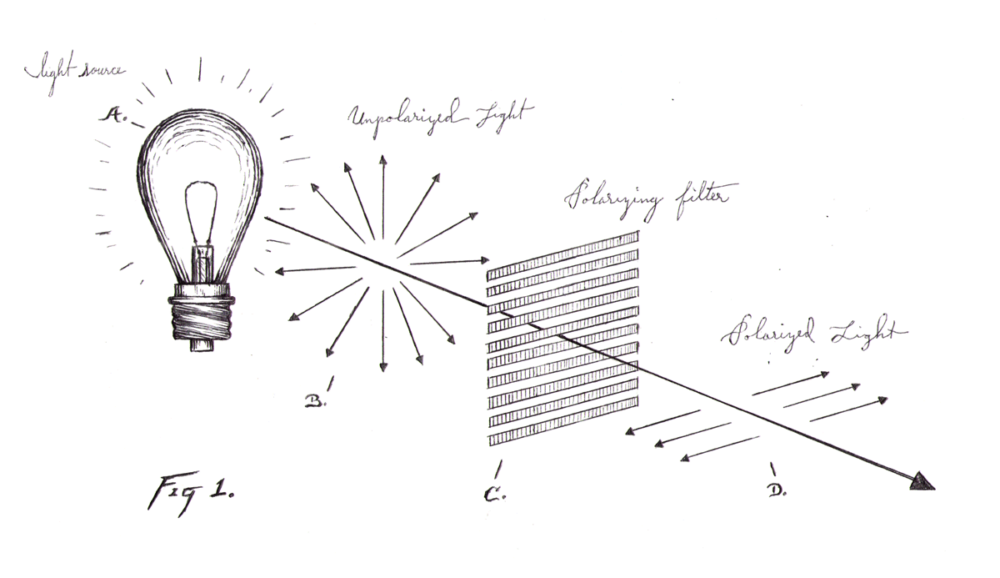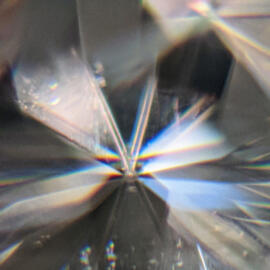The Magic of Polarized Light
How gemologists see what's hidden in plain sight
We use polarized light on a daily basis when we put on our sunglasses, turn on our TV, or sit down at our computer. But, what is polarized light exactly, and why is my jeweler writing about it? It turns out that polarized light is actually a very useful tool in gemology, and in this article we’ll show you why.
What Is Polarized Light?
Light from almost any light source travels in many different directions, and the vibrations around each ray of light are random. This is called unpolarized light. In the gemological world, this would be any light source that we use on a regular basis (e.g. overhead reflected light or a daylight equivalent fluorescent light source).
Polarized light, on the other hand, has all of the vibrations and rays going in the same direction. One of the most common occurrences of this in nature is sunlight reflecting off of the water. When the light bounces off of the surface, that reflected light is partially polarized. This is because some of the rays pass through the water, and some of them reflect. In a lab we typically polarize light by using a polarizing filter. These filters have a coating on them applied in such a way that all of the molecules are aligned with each other so only a certain vibrational direction of light can pass through. This means that all of the light that passes through a polarizing filter is “polarized.”
Common Uses for Polarizing Filters
Polarizing filters are critical to many fields of study. Without them, we wouldn’t be able to easily identify gemstones, TVs and monitors wouldn’t work in the same way, and the latest blockbuster movie wouldn’t pop off the screen the way it does now. Polarizing filters even have uses beyond visible light finding critical roles in tools that work with radio waves, microwaves, and X-rays.
Here are a few of the places you will find polarizing filters in everyday life:
- Sunglasses: Polarized sunglasses help cut through reflections in water and glass so that we can see easier.
- Camera lens/filters: Polarizing lens filters reduce reflections, darken skies, and cuts out glare to help improve photo quality. Some filters can even be rotated on the lens to selectively see through the surface of water or only capture the reflection.
- Modern 3D movies: Unlike old school red and blue 3D movies, modern 3D uses two images along with a pair of glasses that have polarizing filters for lenses. This tricks your brain into thinking you are seeing a three-dimensional object using our perception of depth.
- Liquid crystal displays: Polarizing filters are part of an LCD screen’s core design. Without their ability to align light, LCD screens simply wouldn’t work.
- Radio/X-ray/Microwave: Radios, X-ray machines, and microwaves all use some form of a polarizing filter to allow them to function efficiently as they do without negative side effects.
Using Polarized Light in Gemology
Some gemstones, due to their unique chemical structure, actually polarize light themselves. These gems are doubly refractive (DR) and they will split incoming light in multiple directions. Some common examples of doubly refractive gems are sapphire, tourmaline, and moissanite. These are contrasted with singly refractive (SR) gems like diamond that only bend light in one direction. Gemologists use the term birefringence to refer to how doubly refractive a particular gem is.
By far the most common use of polarized light in gemology is to help identify doubly refractive stones. When using a refractometer, a circular polarizing filter is fitted over the magnifier. When twisted, if the stone is doubly refractive, the refractive index line will jump from one number to the next. Once you know if a stone is doubly refractive or not you can use that information to narrow down the list of possible candidates of what the stone could be.
A great example of this phenomenon can be seen when looking at the facet junctions on a moissanite. When looking through a microscope two images of the facet junction appear. This is because the stone has a high birefringence (i.e. a high amount of double refraction). When you hold a polarizing filter over the stone one of the images disappears; as you rotate the polarizing filter the current image disappears and the second image appears. This is because the two images are transmitted at different angles, and the polarizing filter only allows one angle to pass through at a time. This helps confirm that a stone is doubly refractive and not just cut with unusual, doubled facet junctions.
The Elegance of the Polariscope
Another gemological tool that uses polarized light is the polariscope. Polariscopes have two polarizing filters placed over a light source with a gap in between them to set a gemstone. When the filters are turned 90° from each other to their crossed position the light source is blocked, and the view goes dark. This is because they are both filtering out a different direction of light, and the second one is filtering out the opposite direction of the first. This means that all of the light that makes it through the first filter is then blocked by the second one.
Placing a gemstone in between the polarizing filters and rotating it can tell you some interesting things about it. Because singly refractive stones bend light once, they stay dark the whole time. Doubly refractive stones, on the other hand, refract light in two directions that are energized at 90° from one another. This causes the gemstone itself to act as a 3rd filter between the other two built into the machine. As you rotate the stone, depending on the orientation, it will blink from dark to light. This is because one of the refractions will get blocked but the other one goes through. Aggregate stones like jade, on the other hand, scatter light as it passes through them randomizing it again and negating the first filter. So, they stay light the whole time.
Snake Banding on Glass Gems
Polarized light also has some interesting effects on stones that have strain structures in them. Glass is one of the key examples of this. When rotated in a polariscope with crossed filters, something very strange happens. This visual phenomenon is referred to as snake banding, and it is a result of how the gem is formed. When the gem is cast, as most glass gems are, the inside cools at a slower rate than the outside. This is because the center retains more heat. As it cools and contracts, the surface of the stone is put under a lot of tension from the internal forces pulling in on it. The strain distorts the polarized light showing anomalous double refraction (ADR). Many optics manufacturers use a polariscope to analyze the internal stresses of their glass.
In Conclusion
So there you have it, a brief introduction to polarized light and its many uses in gemology and our day-to-day lives. We hope you enjoyed this article, and remember that if you are in the market for a new diamond or gemstone our trained gemologists have the tools, understanding, and experience to help find the perfect one for you.


Rockhound/mineral hunter here. I stumbled on this trick myself, as I experiment with light/refraction/frequency filtering for fun & I was trying to determine if some old sea glass I had found was actually of earthly origin instead of man.
Strangely I discovered a UV-reactive blue stone (fluoresces intensely green from a sapphire-like blue), and I have no idea what that may be; it was found 20ft off shore in the Pacific, central CA near Santa Cruz.
Any thoughts on what it may be? Still not convinced this isn’t a rare scrap of a strange color of uranium glass from the early 1900s.
Ah well, just a random story from a random guy appreciating the simplicity of your article. Take care, God bless!
Thanks for the kind words, Bobby. That sounds like an interesting stone you found. Without seeing it, our best guess would be synthetic spinel. It can have that nice blue color, and it reacts very strongly to UV light. If you are ever in the Sacramento, CA area, feel free to stop by the shop, and we can take a look at it. 🙂
Thank you very much for this – it’s clear and well written and very interesting. I appreciated reading it. I had heard that some gems go dark in polarized light, and this explains it.
Thanks for the kind words, Helen! I’m glad you enjoyed the article. 🙂